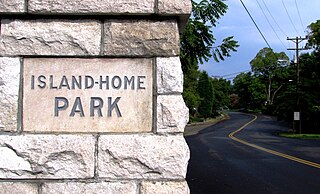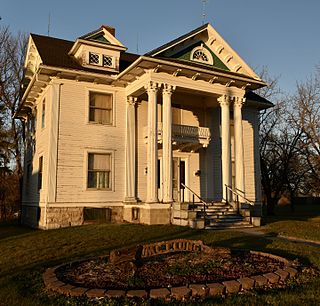
Nellie Letitia McClung was a Canadian author, politician, and social activist, who is regarded as one of Canada's most prominent suffragists. She began her career in writing with the 1908 book Sowing Seeds in Danny, and would eventually publish sixteen books, including two autobiographies. She played a leading role in the women's suffrage movement in Canada, helping to grant women the vote in Alberta and Manitoba in 1916. McClung was elected to the Legislative Assembly of Alberta in 1921, where she served until 1926.

Manitou is an unincorporated urban community in the Municipality of Pembina within the Canadian province of Manitoba that held town status prior to January 1, 2015. The Boundary Trail Railway is based in Manitou. The community's motto is "More Than A Small Town". The community is adjacent to PTH 3 and PR 244. Manitou is surrounded by Mennonite communities and is right next to the St. Leon Wind Farm, the largest wind farm in Manitoba and one of the largest in Canada.

Statesview, or States View, is a historic house located on South Peters Road off Kingston Pike in Knoxville, Tennessee, United States. Built in 1805 by early Knoxville architect Thomas Hope and rebuilt in 1823 following a fire, Statesview was originally the home of surveyor Charles McClung (1761–1835). Following McClung's death, newspaper publisher Frederick Heiskell (1786–1882) purchased the house and estate, which he renamed "Fruit Hill." The house is listed on the National Register of Historic Places for its architecture and political significance.

TheWar Memorial, also known as the Russell A. Alger Jr. House and as the Moorings was dedicated to the memory of veterans and soldiers of World War II. It is located at 32 Lake Shore Drive in Grosse Pointe Farms, Michigan.

Capon Springs, also known as Frye's Springs and Watson Town, is a national historic district in Capon Springs, West Virginia that includes a number of resort buildings ranging in age from the mid-nineteenth century to the early 20th century. The area grew around a mineral spring discovered by Henry Frye in the 1760s, so that by 1787 the town of Watson had been established. By 1850, the 168-room Mountain House Hotel had been built, enduring until it burned in 1911. Also in 1850, the state of Virginia built Greek Revival bath pavilions and the President's House. A period of decline followed the Mountain House fire, but rebuilding began in the 1930s under the ownership of Louis Austin. The resort is still in Austin family ownership.

Island Home Park is a neighborhood in Knoxville, Tennessee, United States, located in the southeastern part of the city along the Tennessee River. Developed as a streetcar suburb in the early 1900s, the neighborhood retains most of its original houses and streetscapes, and is home to the city's largest concentration of Bungalow-style houses. In 1994, several dozen houses in Island Home Park were added to the National Register of Historic Places as the Island Home Park Historic District.

Charles McClung was an American pioneer, politician, and surveyor best known for drawing up the original plat of Knoxville, Tennessee, in 1791. While Knoxville has since expanded to many times its original size, the city's downtown area still roughly follows McClung's 1791 grid. McClung also helped draft Tennessee's constitution in 1796, surveyed and planned what is now Kingston Pike in 1792, and served as Knox County's first court clerk. His home, Statesview, still stands in West Knoxville, and has been listed on the National Register of Historic Places.

The General Building, also called the Tennessee General Building or the First Bank Building, is an office high-rise located in downtown Knoxville, Tennessee, United States. Constructed in 1925, the 14-story building is the only high-rise designed by Charles I. Barber, and has over the years housed the offices of dozens of banks, physicians, and various financial and architectural firms. The Lexington, Tennessee-based First Bank is the current anchor tenant. In 1988, the General Building was listed on the National Register of Historic Places for its architecture and its role in Knoxville's commercial history.

The Knoxville Fire Department is an ISO Class 2 department that provides fire protection and emergency medical services for the city of Knoxville, Tennessee. The department is responsible for 104 square miles (270 km2) with over 180,000 residents.

The Baumann family was a family of American architects who practiced in Knoxville, Tennessee, and the surrounding region, in the late 19th and early 20th centuries. It included Joseph F. Baumann (1844–1920), his brother, Albert B. Baumann, Sr. (1861–1942), and Albert's son, Albert B. Baumann, Jr. (1897–1952). Buildings designed by the Baumanns include the Mall Building (1875), the Church of the Immaculate Conception (1886), Minvilla (1913), the Andrew Johnson Building (1930), and the Knoxville Post Office (1934).
Morlunda, also known as the Col. Samuel McClung Place and Oscar Nelson Farm, is a historic home located near Lewisburg, Greenbrier County, West Virginia. It was built in 1827–1828, and consists of a main house with ell. The main house is a two-story brick building measuring 56 feet long and 21 feet deep. The ell measures 48 feet and it connects to a 1+1⁄2-story formerly detached kitchen.

Pickaway Rural Historic District is a national historic district located at Pickaway, near Union, West Virginia, Monroe County, West Virginia. The district includes 126 contributing buildings, 1 contributing sites, and 7 contributing structures centered on Pickaway and surrounding rural areas. Notable properties in the core include the Reverend John Simpson House (1840), Pickaway School (1890), Trinity Methodist Episcopal South Church (1887), Pickaway Store and Post Office, and frame mill and blacksmith shop. Surrounding farms included in the district are the Gilchrist-Pritt-Perrine farms; Overholt-Gilcrist-Pritt and McClung farms; Beckett, Kilcollin, and Lemon farms; and Siebold and Weikle farms.

This is a list of the National Register of Historic Places listings in Highland County, Virginia.

McDowell is an unincorporated community in Highland County, Virginia, United States. McDowell is 7.2 miles (11.6 km) southeast of Monterey, Virginia on U.S. Route 250. It is in the Bullpasture Valley near the mouth of Crab Run on the Bullpasture River. The community was named after James McDowell, governor of Virginia from 1843 to 1846. McDowell is the location of the May 8, 1862 Battle of McDowell during the American Civil War. The community has a post office with ZIP code 24458 that was established in 1828.

Clover Creek is an unincorporated community in Highland County, Virginia, United States. Clover Creek is located 10 miles (16 km) south-southeast of Monterey, Virginia, on State Route 678. The community is situated in the Bullpasture Valley along the path of the Bullpasture River. Beginning in 1897 with a decision by the United States Board on Geographic Names, the community was officially referred to as the single-word "Clovercreek"; however, in 1970, the board modified the community's name to the current two-word "Clover Creek". During the French and Indian War, a British fort named Fort George was built near Clover Creek in 1754 consisting of a wooden stockade 90 feet (27 m) square. The fort was never directly attacked, though arrows were at one point launched against the fort from a distance leaving no damage. George Washington may have visited the fort while traveling in the area, marking the only time Washington visited the region which is now known as Highland County.

McClung Farm Historic District is a historic home and national historic district located at McDowell, Highland County, Virginia. The district encompasses seven contributing buildings, three contributing sites, and three contributing structures. The main house was built in 1844, and is a two-story, five bay, brick dwelling with a single-pile, central-passage plan and an original two-story rear addition in a vernacular Federal style. It has a three bay wide front porch. The contributing buildings and structures besides the house include: a large barn, a small barn, a cattle ramp, an outhouse, a corncrib, a smokehouse, a shed, and the Clover Creek Presbyterian Church and its outhouse. The contributing sites are a wood shed foundation, the ruins of the McClung Mill, and the Clover Creek Presbyterian Church cemetery.

Fairfax is a historic mansion in White Pine, Jefferson County, Tennessee, USA.

The J.J. McClung House is a historic structure located in Garden Grove, Iowa, United States. A native of Ohio, James Johnson McClung moved to Garden Grove in 1879. He owned and operated a livery and dray business, where he carried the mail from the train to the post office for 53 years. With the advent of the automobile, he built the first service station in Decatur County in 1925. The house was built from 1908 to 1909 by Wiley Sells of Leon, Iowa and remained in the McClung family for 80 years. It was added to the National Register of Historic Places in 1990.

Farm No. 266—Johnny Cash Boyhood Home was the home of singer-songwriter Johnny Cash from 1935 to 1950. Cash moved with his family to a rural community in Mississippi County, Arkansas. The farm house was built in 1934 in a government project to help boost the economy. The Cash family joined the community in March of 1935. Ray and Carrie Cash moved to Arkansas when they took an offer to farm government land for poor and impoverished farmers. The Cash family went through many hard ships while living in the farm house by floods and losing one of their children, Jack Cash. Growing up picking cotton and working on the farm influenced some of Johnny Cash's songs in the future, one of them being "Pickin' Time." In 2018, the home was listed on the National Register of Historic Places.

James White McClung was an American lawyer and politician during the early days of Alabama statehood. He served in the Alabama state legislature between 1822 and 1844, was Speaker of the House from 1835–1838, and served in the state Senate from 1845–1849. At the time of his death he was a candidate for the United States Senate, without opposition. McClung Avenue in Hunstville is named for him, the first street in that city to be named after a local citizen.






















